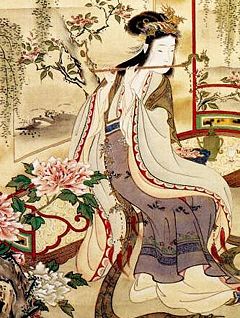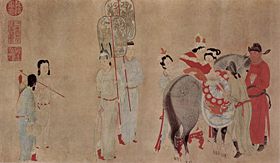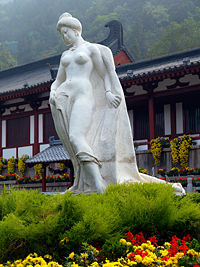Yang Guifei
- This is a Chinese name; the family name is Yang.
Yáng Guìfēi (Simplified Chinese: 杨贵妃; Traditional Chinese: 楊貴妃; pinyin: Yáng Guìfēi) (literally means, "precious princess consort") (June 1, 719 — July 15, 756), born Yáng Yùhuán (楊玉環), was one of the Four Beauties of ancient China (Si Mei Ren). She was the beloved consort of the Tang Emperor Xuanzong (685-762). Emperor Xuanzong preferred her over thousands of concubines and spared no expense to please her. He became infatuated and increasingly ignored the day-to-day affairs of his empire, allowing much of his power to fall into the hands of corrupt court officials, including Yan Guifei’s cousin Yang Guozhong, who became Chief Minister.
In 755, An Lu-shan, a foreign general who had been a court favorite, began the Rebellion of Anshi, taking the capital of Chang’an and declaring himself emperor. Xuanzong and his court fled to Chengdu, but along the way enraged Imperial troops, convinced that the rebellion was the fault of the Yang family, demanded the deaths of Yang Guizhong, Yang Guifei, and her sisters. Yang Guifei was hanged with a silken cord and the Emperor abdicated and lived the rest of his life in seclusion. Yang Guifei became a cultural legend and the subject of numerous books, dramas, and poems, including “Song of the Everlasting Sorrow” by the Tang poet, Bai Juyi.
Life
Yang was born in Yongle (永樂), Pu Prefecture (蒲州), with an ancestry in Huaying (華陰), Hongnong (弘農) (in Shaanxi) to Yang Xuanyan (楊玄琰), the sihu (司戶), a census official, in Sichuan, Shu Prefecture (蜀州). Her father died while she was very young, and she was raised in the house of her uncle. A few years after her father's death, sixteen-year old Yang married one of Emperor Xuanzong's many sons, the sixteen-year old Li Mei (李瑁), Prince Shou (壽王), and became the "princess Shou" (壽王妃).
Three years after Emperor Xuanzong's consort Wu Huifei (武惠妃) died in 737, the highly-placed eunuch adviser Gao Lishi arranged for Xuanzong to meet Yang in the Xingwen Fountain Palace (幸溫泉宮). The emperor then made Yang divorce her husband the prince and become a Taoist nun with the sobriquet Taizhen (太真 "Utmost Truth") living in Taizhen Palace. Five years later, Prince Li Mei was given another wife, the daughter of General Yuan Zhaoxun (韋昭訓), and Yang was then made a guifei (imperial consort). The Emperor Xuanzong was then sixty-one, and Yang was twenty-six.
Xuanzong was infatuated with Yang Guifei and elevated her above thousands of concubines, to their dismay. He rebuilt the ancient hot springs palace at the foot of Lishan Mountain for his consort and her sisters, naming it Huaqing Palace, and heaped honors on members of Yang’s family. Her relatives gained unprecedented influence at court. Her uncle, Xuangui, was made a senior official in the capital; her cousin, Yang Guozhong, was appointed prime minister; her elder brother, Yangxian, became an official of the second rank; and her younger brother, Yangqi was given an imperial consort as his wife. Members of the Yang family married two Li princesses and two prefects. Her sisters were all appointed to nobility:
- Her eldest sister became Lady of Han (韓國夫人) (Note: the name 韓國 does not correspond to the autonym of either China or modern-day Korea)
- Her third eldest sister became Lady of Guo (虢國夫人)
- Her eighth eldest sister became Lady of Qin (秦國夫人)
The Emperor was a skilled musician, and Yang Guifei was a singer and dancer; together they often performed the Rainbow Feather Garment Dance. Every year at the Festival of the Cowherd and Weaver Maid, on the seventh day of the seventh lunar month (usually in August), Xuanzong pledged his eternal love to Yang. Hundreds of musicians and dancers were brought to court to entertain her.[1] Imperial messengers rode day and night to bring Yang’s favorite fruit, lychee, to Chang’an (modern Xian) from Guangzou (Canton), more than 1,500 miles to the south. (Some historians believe the fruits came from her home in modern Sichuan.)
- “Her hair like a cloud, her face like a flower,
- A gold hair-pin adorning her tresses.
- Behind the warm lotus-flower curtain,
- They took their pleasures in the spring night.
- Regretting only the spring nights were too short;
- Rising only when the sun was high;
- He stopped attending court sessions
- In the early morning.
- Constantly she amused and feasted with him,
- Accompanying him on his spring outings,
- Spending all the nights with him.
- Though many beauties were in the palace,
- More than three thousand of them,
- All his favors were centered upon her" (Bai Juyi, Song of the Everlasting Sorrow).
As Xuanzong turned his attention to pleasure-seeking with Yang and her family, he paid less and less attention to the running of his empire, and much of his power fell into the hands of court officials like the corrupt but competent chief minister Li Linfu (李林甫) and the influential court eunuch Gao Lishi (高力士). The political influence of the old aristocracy increased, and after 737, Li Lin-fu became a virtual dictator. From 740, the Emperor had less and less control of government affairs.
General An-Lushan, the son of a Sogdian officer and a Turkish mother from a noble family, was made a military governor of modern Heibei province in 744, by Li lin-fu, who favored foreign generals because he feared that Chinese generals might usurp his authority at court. He paid frequent visits to the capital and became a personal favorite of Xuanzong and Yang Guifei. An Lu-shan was extremely fat, and often played the jester to win favor. On one occasion, three days after his birthday, he was taken into the women’s quarters of the palace dressed as a baby, and put through a mock adoption ceremony by Yang. This type of conduct led to rumors of an inappropriate relationship between Yang and An Lu-shan. Through Yang’s patronage, An Lu-shan rose to prominence. In 750, he was honored with the title of Prince, and in 751, he was made the military governor of Hotung, giving him control of the eastern half of China’s frontier, and putting him in control of 40 percent of the Tang forces.
In 752, Li Lin-fu died and was succeeded as Chief Minister by Yang Guifei's dissolute cousin Yang Guozhong( 楊國忠, Yáng Guózhōng), who disliked An Lu-shan and actively opposed him. Around that time, An Lu-shan’s army was thoroughly defeated in a campaign against the Khitans, and China suffered other military setbacks at the hands of the Arabs in the Battle of Talus and Nanzhao in southern China. A series of natural disasters, including drought, severe storms, and floods, which caused terrible suffering among the Chinese people, were perceived as signs that Heaven was displeased with the conduct of the Emperor.
In 755, An Lu-shan took control of the northern provinces of Heibei and Henan, entered Luoyang, and proclaimed a new dynasty, initiating the Anshi Rebellion. Six months later, his forces took Chang’an. The emperor and court made their escape to Chengdu. A little more than a hundred li from the capital, at Mawei Relay Station (馬嵬驛站) (today in Xingping (興平縣), Shaanxi), the soldiers and officers accompanying the imperial party refused to move on, demanding the deaths of Yang Guozhong and Yang Guifei, whom they held responsible for the rebellion. Yang Guozhong was executed by soldiers. Rather than turn herself over to them, Yang (then thirty-eight) hanged herself, or was hanged by Gao Lishi, on a tree, with a silken cord reportedly given to her by the Emperor. The following year, the devastated Xuanzong tried to retrieve her body from the Mawei Relay Station, but no body was ever found, so a memorial tomb for her was erected in Xi. Xuanzong abdicated in favor of his son and spent the remainder of his life in retirement, mourning her loss.
- “The emperor's green-canopied carriage
- Was forced to halt,
- Having left the west city gate
- More than a hundred li.
- There was nothing the emperor could do,
- At the army's refusal to proceed.
- So she with the moth-like eyebrows
- Was killed before his horses.
- Her floral-patterned gilded box
- Fell to the ground, abandoned and unwanted,
- Like her jade hair-pin
- With the gold sparrow and green feathers" (Bai Juyi, Song of the Everlasting Sorrow).
A Japanese myth arose that she was rescued, escaped to Japan, and lived her remaining life there. In Japanese, she is known as Youkihi. In the following generation, a long poem, Song of the Everlasting Sorrow (長恨歌), was written by the Tang poet Bai Juyi, describing the Emperor's love for her and his perpetual grief at her loss; it became a classic, still memorized today by Chinese schoolchildren.
- “Heaven and earth may not last for ever,
- But this sorrow is eternal" (Bai Juyi, Song of the Everlasting Sorrow)
Yang Guifei is known for being slightly overweight, which was a much sought-after quality at the time. Western misinterpretation of quotes describing her beauty have often led to her being characterized as "obese." The term "obese," when used to describe Yang Guifei, must not be understood with the modern meaning of being extremely overweight. She was often compared and contrasted with another great Chinese beauty, Zhao Feiyan (趙飛燕), the beautiful wife of Emperor Cheng of Han, because Yang was known for her full build while Zhao was known for her slender build. This led to the four-character Chinese idiom, yanshou huanfei (燕瘦環肥), describing the range of the types of beauty.
Cultural legacy
Yang's story has been often retold. While some literature describes her as the author of much misfortune, other writings sympathize with her as a scapegoat. The stories about her include:
Literature:
- The Song of Eternal Sorrow (長恨歌) by Bai Juyi
Operas
- Guifei Intoxicated (貴妃醉酒 Guifei Zuijiu)
- The Unofficial Biography of Taizhen (太真外傳 Taizhen Waizhuan)
- The Slope of Mawei (馬嵬坡 Mawei Po) by Chen Hong (陳鴻)
Novels:
- The Unofficial Biography of Yang Taizhen (楊太真外傳 Yang Taizhen Waizhua)
- The Biography-Song of the Everlasting Sorrow (長恨歌傳 Changhen Kezhuan)
- The Court of the Lion (modern English novelization)—Eleanor Cooney, Daniel Altieri (ISBN 0-87795-902-1)
- The Favourite Monkey of the Tang House (Любимая мартышка дома Тан, modern Russian novelization)—Master Chen (ISBN 5-98695-025-9)
Drama plays:
- The Hall of Longevity (長生殿 Changshen Dian) by (洪升) of the Qing Dynasty
- The Mirror to Grind Dust (磨塵鑒 Mocheng Jian) by an anonymous of the Ming Dynasty
- The Records of Shocking Grandeur (驚鴻記 Jinghong Ji) by (吳世美) of the Ming Dynasty
- The Records of Colourful Hair (彩毫記 Caihao Ji) by (屠隆隆) of the Ming Dynasty
- The Ming Emperor of Tang China in an Autumn Night with Kola Nut and Rain (唐明皇秋夜梧桐雨 Tang Minghuang Qiuye Wutong Yu) by Bai Pu (白樸) of the Yuan Dynasty
Movies and Television:
- Princess Yang Kwei-Fei (aka The Empress Yang Kuei-Fei) (楊貴妃 Yōkihi, 1955) by Kenji Mizoguchi
- Yang Kwei Fei (aka The Magnificent Concubine, 1962) directed by Li Han Hsiang
- The Legend of Lady Yang (TVB) Starring Anne Heung
She is also well-known in Japanese literature, and Noh plays have been staged based on her story.
Notes
- ↑ Alan Perry, Encyclopedia of China (New York: Roundtable Press., 2000). ISBN 0816026939
ReferencesISBN links support NWE through referral fees
- Grousset, René. 1970. The Empire of the Steppes; a History of Central Asia. New Brunswick, N.J.: Rutgers University Press. ISBN 0813506271
- Lu, Yanǵuang, Zhuozhi Cai, and Kate Foster. 2001. 100 Celebrated Chinese Women. Singapore: Asiapac. ISBN 9813029811
- Owen, Stephen. 1996. An Anthology of Chinese Literature: Beginnings to 1911. New York: W.W. Norton. ISBN 0393038238
- Perry, Alan. 2000. Encyclopedia of China. New York: Roundtable Press. ISBN 0816026939
- Twitchett, Denis Crispin and John King Fairbank. 1978. The Cambridge History of China. Cambridge: Cambridge University Press. ISBN 0521214475
- Wu, Shu-ch’iung Huang. 1923. Yang Guifei, the Most Famous Beauty of China. Shanghai: Commercial Press.
External links
All links retrieved May 22, 2023.
- The Yang Kwei-fei story Yang Kwei-fei and The Song of Eternal Sorrow in The Tale of Genji.
Credits
New World Encyclopedia writers and editors rewrote and completed the Wikipedia article in accordance with New World Encyclopedia standards. This article abides by terms of the Creative Commons CC-by-sa 3.0 License (CC-by-sa), which may be used and disseminated with proper attribution. Credit is due under the terms of this license that can reference both the New World Encyclopedia contributors and the selfless volunteer contributors of the Wikimedia Foundation. To cite this article click here for a list of acceptable citing formats.The history of earlier contributions by wikipedians is accessible to researchers here:
The history of this article since it was imported to New World Encyclopedia:
Note: Some restrictions may apply to use of individual images which are separately licensed.


